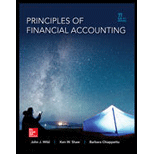
1.
Compute the break-even point in dollar sales for each product.
1.
Explanation of Solution
Break-Even Point: It is the point of sales at which entity neither earns a profit nor suffers a loss. It can also be said that the point of sales at which sales value of the entity recovers the entire cost of fixed and variable nature is called break-even point
For product T:
Given, 50,000 units sold for $2,000,000, variable costs incurred is $1,600,000, and fixed costs are $125,000. Contribution margin ratio is 20% (Working note 1).
Compute the break-even point in dollar sales for year:
Therefore, break-even sales for Product T for the year are $625,000.
Working note1: Compute the contribution margin ratio
| Sales price per unit | $40 |
| Variable costs per unit | $32 |
| Contribution margin per unit (B) | $8 |
| Contribution margin ratio | 20% |
Table (1)
For product O:
Given, 50,000 units sold for $2,000,000, variable costs incurred is $250,000, and fixed costs are $1,475,000. Contribution margin ratio is 87.5% (Working note 2).
Compute the break-even point in dollar sales for year:
Working note 2: Compute the contribution margin ratio
| Sales price per unit | $50 |
| Variable costs per unit | $5 |
| Contribution margin per unit (B) | $45 |
| Contribution margin ratio | 87.5% |
Table (1)
Therefore, break-even sales for Product O for the year are $1,685,714.
2.
Prepare the contribution margin income statement.
2.
Explanation of Solution
Contribution margin income statement: It is a kind of income statement which reports the sales, variable costs, contribution margin, fixed costs, and net profit.
Sales are declined to 30,000 units. Therefore revised sales for product T are $1,200,000
Prepare the contribution margin income statement:
| Company H | ||
| Product T | Product O | |
| Sales | $1,200,000 | $1,200,000 |
| Less: Variable costs | 960,000 | 150,000 |
| Contribution margin | 240,000 | 1,050,000 |
| Less: Fixed costs | 125,000 | 1,475,000 |
| Income before taxes | 115,000 | (425,000) |
| Less: Income taxes (32%) | 36,800 | (136,000) |
| Net income | $78,200 | $(289,000) |
Table (2)
Therefore, net income for Product T is $78,200 and net loss for Production O are $289,000.
3.
Prepare the contribution margin income statement.
3.
Explanation of Solution
Contribution margin income statement: It is a kind of income statement which reports the sales, variable costs, contribution margin, fixed costs, and net profit.
Sales are increased to 60,000 units. Therefore revised sales for product T are $2,400,000
Prepare the contribution margin income statement:
| Company H | ||
| Forecasted Contribution Margin Income Statement | ||
| Product T | Product O | |
| Sales | $2,400,000 | $2,400,000 |
| Less: Variable costs | 1,920,000 | 300,000 |
| Contribution margin | 480,000 | 2,100,000 |
| Less: Fixed costs | 125,000 | 1,475,000 |
| Income before taxes | 355,000 | 625,000 |
| Less: Income taxes (32%) | 113,600 | 200,000 |
| Net income | $241,000 | $425,000 |
Table (3)
Therefore, net income for Product T is $241,000 and for Production O is $425,000.
4.
Identify the product that would experience a greater loss when the sales are decreases greatly. Explain the same.
4.
Explanation of Solution
Product O will experience a greater loss when the sales are decreased greatly. When the sales decreased to zero sales then Product O’s loss is equal to its fixed cost amount ($1,475,000), where Product T’s loss will be equal to $125,000.
5.
Describe some factors that might have created the different cost structures for these two products.
5.
Explanation of Solution
Factors that could cause Product T to have lower fixed costs might include:
- The labours are paid based on the units produced.
- Sales representatives work only on the basis sales commission.
- Managers are remunerated with a share of profits instead of salaries.
- Assets that are used in production of Product T are taken on lease with the rent based on asset usage.
In contrast, fixed costs for Product O may be higher because of:
- A salary structure that is not based on production or sales.
- Product O's assets that are owned or obtained under a lease agreement based on time, and not on asset usage.
Want to see more full solutions like this?
Chapter 21 Solutions
Principles of Financial Accounting.
- Goodwill is an example of an indefinite-life intangible asset, meaning that public companies must test it for impairment rather than regularly amortizing to systematically reduce its value on the balance sheet of the public company. Can anyone recap the difference between limited-life versus indefinite-life intangible assets? Any specific examples of either category?arrow_forwardWhy are adjusting journal entries necessary at the end of an accounting period? Need hearrow_forwardWhy are adjusting journal entries necessary at the end of an accounting period?i need helparrow_forward

 AccountingAccountingISBN:9781337272094Author:WARREN, Carl S., Reeve, James M., Duchac, Jonathan E.Publisher:Cengage Learning,
AccountingAccountingISBN:9781337272094Author:WARREN, Carl S., Reeve, James M., Duchac, Jonathan E.Publisher:Cengage Learning, Accounting Information SystemsAccountingISBN:9781337619202Author:Hall, James A.Publisher:Cengage Learning,
Accounting Information SystemsAccountingISBN:9781337619202Author:Hall, James A.Publisher:Cengage Learning, Horngren's Cost Accounting: A Managerial Emphasis...AccountingISBN:9780134475585Author:Srikant M. Datar, Madhav V. RajanPublisher:PEARSON
Horngren's Cost Accounting: A Managerial Emphasis...AccountingISBN:9780134475585Author:Srikant M. Datar, Madhav V. RajanPublisher:PEARSON Intermediate AccountingAccountingISBN:9781259722660Author:J. David Spiceland, Mark W. Nelson, Wayne M ThomasPublisher:McGraw-Hill Education
Intermediate AccountingAccountingISBN:9781259722660Author:J. David Spiceland, Mark W. Nelson, Wayne M ThomasPublisher:McGraw-Hill Education Financial and Managerial AccountingAccountingISBN:9781259726705Author:John J Wild, Ken W. Shaw, Barbara Chiappetta Fundamental Accounting PrinciplesPublisher:McGraw-Hill Education
Financial and Managerial AccountingAccountingISBN:9781259726705Author:John J Wild, Ken W. Shaw, Barbara Chiappetta Fundamental Accounting PrinciplesPublisher:McGraw-Hill Education





